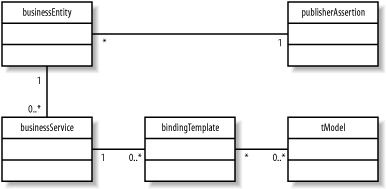11.2 Web Services Standards
| The work of establishing basic standards for Web Services isn't complete. Specifications exist for discovery, description, transport, and encoding. Some of these specifications have been submitted to the W3C to become standards (recommendations). 11.2.1 Extensible Markup LanguageBoth encoding schemes, XML-RPC and SOAP, are XML 1.0 applications. XML-RPC is a fairly simple XML application, so it uses only basic XML syntax. SOAP is a more complex application that makes extensive use of namespaces and XML Schemas. 11.2.2 XML-RPCXML-RPC is a Web Service specification that uses a small XML vocabulary to encode its request and result messages and HTTP as the transport protocol. XML-RPC is a lightweight Web Service implementation that has limited datatype support. Regardless, it is effective and has implementations for most programming languages and operating systems. Oracle Application Server doesn't provide direct support for XML-RPC; however, that doesn't mean you can't use it with Oracle Application Server. Because XML-RPC has implementations in C, C++, Perl, and Java, you can deploy any of these implementations on Oracle Application Server. You can find the specifications and a list of implementations for XML-RPC at http://www.xmlrpc.com. 11.2.3 SOAPSOAP 1.1, originally called Simple Object Access Protocol when IBM and Microsoft, among others, submitted it to the W3C in April of 2000, is now an acronym without a name. SOAP 1.2 was released as an official recommendation in June of 2003. The working group decided that the name did not correctly describe the standard, so they dropped the name but kept the acronym. Oracle Application Server currently supports SOAP 1.1 with two implementations:
Of course, as with XML-RPC, you can also deploy on Oracle Application Server any third-party SOAP implementation, or agent as the W3C calls it, that is written in C, C++, Perl, or Java. You can find specifications for SOAP at http://www.w3.org/2002/ws/. 11.2.4 Web Services Description LanguageWeb Services Description Language, an XML application, describes a Web Service specification in a computer-readable format. A WSDL document describes:
The WSDL 1.1 specification submitted by IBM, Microsoft, and Oracle, among many others, to the W3C in March 2001, has been in working draft status for a Version 2.0 since November 2003. At the time this book is being written, Oracle Application Server tools currently support WSDL 1.1. Oracle Application Server Web Services deployments expose a service's WSDL document at the service's endpoint. You can find the specification for WSDL at http://www.w3.org/2002/ws/. 11.2.5 Universal Description, Discovery, and IntegrationUniversal Description, Discovery, and Integration is a specification for a network-accessible directory of available Web Services. UDDI contains information about several entities in its XML Schema:
This information is usually found in the form of a WSDL document. The additional entity, publisherAssertion , defines relations between two business entities. The relationship between these entities is outlined in Figure 11-3. As of this writing, the UDDI specification has not been submitted to the W3C. Figure 11-3. A UDDI data model Oracle Application Server tools support UDDI 2.0. In addition, Oracle Application Server provides a UDDI directory that can be used to publish Web Services on your corporate intranet or be synchronized with UDDI directories on the Internet. The Oracle Application Server UDDI agent is managed through Application Server Control. You can find the specification for UDDI at http://www.uddi.org/specification.html. |
EAN: 2147483647
Pages: 120